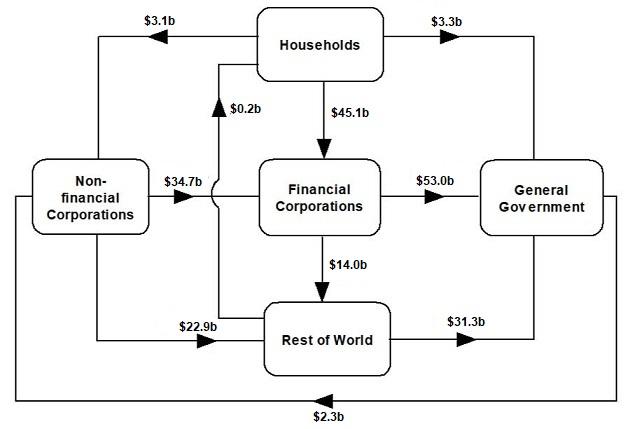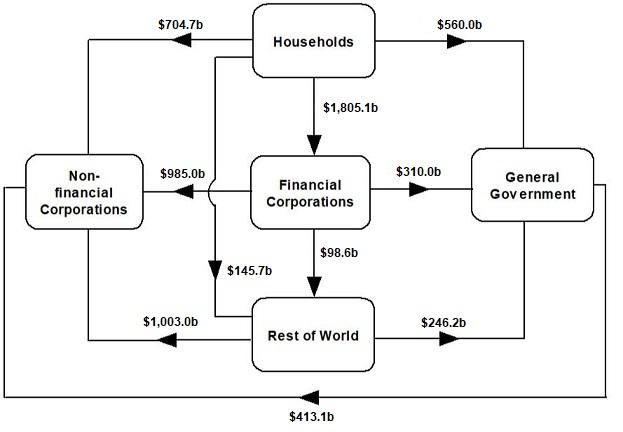Articles
This quarter's Finance and Wealth includes the following articles:
Financing resources
Total financing resources available to the Australian economy rose by $16.7b to $126.9b for the June quarter. Gross saving was the biggest driver with:
- $76.8b gross saving by households, an increase of $25.1b from the March quarter
- $77.8b gross saving by non financial corporations, an increase of $47.6b from the March quarter
Gross saving by general government was -$63.6b, a decrease of $77.7b from the March quarter. The large fall in saving reflects the government's economic response to the COVID-19 pandemic, which resulted in record high subsidy payments to households and businesses.
Financing resources table
| Non-financial corps | Financial corps | Government | Households | Total national | Rest of world | |
|---|---|---|---|---|---|---|
| Net saving (a) | 34.4 | 14.6 | -74.7 | 45.4 | 19.7 | -19.2 |
| plus Consumption of fixed capital | 43.4 | 3.2 | 11.1 | 31.4 | 89.1 | - |
| Gross saving | 77.8 | 17.8 | -63.6 | 76.8 | 108.8 | -19.2 |
| plus Net capital transfers | 0.4 | 0.0 | -3.0 | 2.4 | -0.2 | 0.2 |
| less Statistical discrepancy (b) | - | - | - | - | -18.3 | - |
| Total financing resources | 78.1 | 17.8 | -66.5 | 79.2 | 126.9 | -19.0 |
- nil or rounded to zero
(a) Net saving for the rest of world is the balance on the external income account.
(b) The statistical discrepancy is not able to be distributed among the sectors.
Capital formation
Capital formation for the June quarter was $107.9b. This is 6.9% lower than the level in June 2019 and the lowest since 2011.
Total financing resources available exceeded the level of capital formation resulting in Australia being a net lender in the June quarter.
Capital formation and financial investment table
| Non-financial corps | Financial corps | Government | Households | Total national | Rest of world | ||
|---|---|---|---|---|---|---|---|
| Capital formation | |||||||
| Gross fixed capital formation | 50.8 | 3.1 | 24.4 | 36.9 | 115.2 | - | |
| plus Changes in inventories | -7.2 | 0.0 | 1.7 | -1.8 | -7.3 | - | |
| plus Net acquisition of non-produced non-financial assets | -0.2 | - | 0.2 | - | - | - | |
| Total capital formation | 43.4 | 3.1 | 26.3 | 35.1 | 107.9 | - | |
| plus Financial investment | |||||||
| Aquistition of financial assets | 37.9 | -53.2 | 58.1 | 76.0 | -156.2 | -174.6 | |
| less Incurrence of financial liabilities | -1.9 | -57.9 | 146.7 | 13.4 | -174.6 | -156.2 | |
| Net Financial investment (Net lending (+) / net borrowing (-)) | 39.8 | 4.7 | -88.6 | 62.5 | 18.4 | -18.4 | |
| less Net errors and omissions | 5.1 | -10.0 | 4.2 | 18.4 | -0.6 | 0.6 | |
| Total investment | 78.1 | 17.8 | -66.5 | 79.2 | 126.9 | -19.0 | |
- nil or rounded to zero
Financial investment
Australia was a net lender of $18.4b in the June quarter, the strongest on record. It was also Australia's fifth consecutive quarter of net lending. This was due to a $174.6b decrease in liabilities to rest of world (ROW) driven by:
- $50.6b in net maturites of debt securities (one name paper and bonds) held by ROW and issued by authorised deposit taking institutions (ADIs)
- $97.0b in settlements of derivative contracts with ROW
ADIs sourced alternative, lower cost forms of funding such as deposits and RBA's term funding facility, rather than issuing debt overseas.
Households' $62.5b net lending position was the result of a $76.0b acquisition of assets and a $13.4b incurrence of liabilities, driven by:
- $33.4b increase in deposits
- $13.3b increase in loan liabilities
The increase in deposits reflects increased household saving due to government income support packages combined with reduction in consumption due to COVID-19. The increase in loan liabilities was as a result of refinancing activity and deferred loan repayments relating to housing loans.
Non-financial corporations' $39.8b net lending position was due to a $37.9b acquisition of assets and a $1.9b decrease in liabilities, driven by:
- $32.0b increase in deposits
- $33.2b repayment of loan liabilities
- partly offset by $26.2b in equity raisings
General government's $62.5b net borrowing position was due to a $146.7b increase in liabilities, driven by:
- A record $106.6b issuance of debt securities (one name paper and bonds)
- $29.4b increase in loan liabilities
Increases in both debt security issuance and loan liabilities were used to mainly fund COVID-19 related economic support policies. For further analysis, see - Financing COVID-19 government policies
Financial market summary table
Amounts outstanding, Mar-20 | Transactions, Jun-20 | Other changes, Jun-20 | Amounts outstanding, Jun-20 | ||
|---|---|---|---|---|---|
| Currency and deposits | |||||
| Currency | 89.5 | 4.8 | - | 94.2 | |
| Transferable deposits | 1,353.3 | 44.6 | -2.7 | 1,395.3 | |
| Other deposits | 1,527.1 | -3.2 | -24.0 | 1,499.9 | |
| Short term debt securities | |||||
| Bills of exchange | 18.1 | -2.0 | - | 16.1 | |
| One name paper | 525.5 | -0.2 | -15.3 | 510.1 | |
| Long term debt securities | |||||
| Bonds, etc. | 2,994.8 | 199.4 | -44.6 | 3,149.5 | |
| Derivatives | |||||
| Derivatives | 1,248.5 | -245.0 | -9.5 | 994.1 | |
| Loans and placements | |||||
| Short term | 461.5 | -15.0 | -9.3 | 437.2 | |
| Long term | 4,122.3 | -18.4 | -36.1 | 4,067.8 | |
| Shares and other equity | |||||
| Listed | 1,588.6 | 30.9 | 286.4 | 1,905.9 | |
| Unlisted | 4,743.4 | -2.4 | 64.4 | 4,805.3 | |
| Insurance technical reserves | |||||
| Reserves of pension funds and life | 2,472.6 | 21.9 | 142.3 | 2,636.9 | |
| General insurance payments | 131.3 | -1.0 | - | 130.3 | |
- nil or rounded to zero
Flow of funds diagrams
Net transactions during June quarter 2020
Image

Description
Amounts outstanding at end of June quarter 2020
Image
